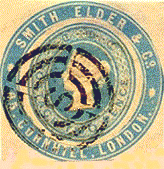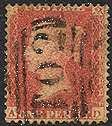
T04 through T06

T04 through T06
I have searched various resources: handbooks, journals, and various specialists for information about this postmark and have found very little information. This postmark is very scarce on stamps, uncommon on postal stationery, and very rare or none existent on cover.Literature:
In The Encyclopedia of British Empire Postage Stamps, Volume 1, it is illustrated along with the comment: "Traveling Post Office?"
Explanations for this Postmark have been handled conservatively by specialists, each proposing a theory of the postmark's function, but cautioning that their ideas are inconclusive and not based on any certain evidence.In their handbook, The Postmarks of Great Britain and Ireland, Alcock and Holland propose the following: "The resemblance [of this postmark] to the "1844" English provincial series of of numbered obliterators will be noticed at once. There is another variety with horizontal bars also forming an upright oval. These numbered "T.O." stamps probably belong to the group which Hendy says were impressed at the inland section of the London
G.P.O. on letters sent to the Traveling Post Offices which could not be included in the regular mail bags, owing to the late hour at which they were posted." They word to focus on here is "probably." The connection of this postmark with the TPO based upon the "TO" has since fallen out of favor.In H.C. Westley's detailed study, The Postal Cancellations of London 1840-1890, the postmark is placed in the chapter on the Foreign Branch cancellations. He explains: "On 30 April 1860, six stamps were issued showing T.O.1 to T.O.6. These are frequently found on W.H. Smith & Son's wrappers, but I have not succeeded in finding out anything concerning there use."
I also found a Journal article which I have sadly lost track of which proposed that the postmarks "were issued on 30 April 1860 for use in the Foreign Branch of the Circulation Department at St. Martin's le Grand. They were possibly used for ship or naval letters, or both, passing through the Circulation Department. All Royal Navy letters went to St. Martin's le Grand for redirection." I regret that I have lost the original source but had carefully recorded the comments.
Wrappers:
I must agree with Westley's observation that many of the examples of these postmarks appear on stationery. Most of my own examples exist on wrapper cut squares with W.H. Smith & Sons advertisement collars. I have examples of "T.O.2" and "T.O.6" on the twopence embossed wrapper in blue with collars stating "W.H. Smith & Sons, 186, Strand, London." For obvious reasons, a great many of the wrappers are canceled with the "pre-cancels of Smith, Elder & Co., Henry S. King & Co., and William Dawson & Sons. The fact that they appear with some regularity on the wrappers along with the pre-cancels would lead one to the possible idea that they were used somehow as a substitute pre-cancel for any of the above firms or perhaps for a firm which remains unrecorded. I reproduce the pre- cancels below:
 |
|||
 |
 |
 |
 |
|
|
|
|
|
|
|
|
|
Stamps:
I have found examples of the "T.O." postmark on the following stampsLine-Engraved:
The 1857 Perforated Star Die II, Alphabet III, Watermarked Large Crown ( T.O.1 and T.O.2 in black ink)
The 1864 Penny Red with Letters in Four Corners (T.O.1 and T.O.2 in black and red ink)
In regards to the 1857 perforated Stars I have only found these postmarks on Reserve Plat 15 and 17.
 |
 |
 |
 |
 |
|
|
|
|
|
|
Surface Printed Issues
 |
 |
|
|
|
|
|
Surface printed Issues:
1867 3d. Rose with Large White Corner Letters, watermarked Spray of Rose, Plate 15. This
is an interesting example because it clearly does not contain a number, but only the "T.O."1872 6d. Chestnut with Large White Corner Letters watermarked Spray of Rose, Plate 11.
In this case it is "T.O.2."1862 1s. Green with Large White Corner Letters watermarked Heraldic Arms, Plate 4.
"T.O.2 again (see illustration above).I would be very grateful to hear from anyone else who has stationery or stamps canceled with
these marks or additional sources of information about them.
24May99